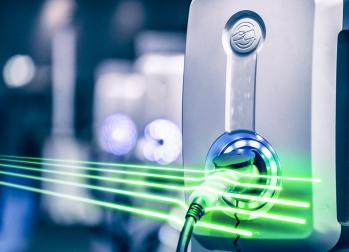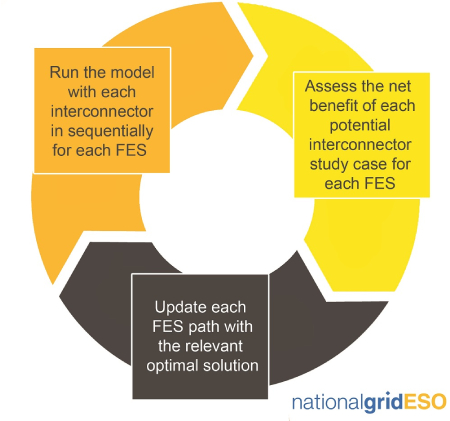The NOA is our recommendation for which reinforcement projects should receive investment during the coming year to facilitate the development of an efficient, coordinated, and economical system of electricity transmission. This must be consistent with the National Electricity Transmission System Security and Quality of Supply Standard (NETS SQSS), as well as the development of efficient interconnection capacity.
The NOA methodology describes how we assess the required levels of network transfer, the options available to meet this requirement and recommends options for further development. The methodology also describes the end to end process from the analysis to the publication of the NOA report and identifies the roles and responsibilities of the Electricity System Operator (ESO) and onshore Transmission Owners (TOs). The holistic network design (HND) and offshore transmission network review (OTNR) are considered in our NOA work.

NOA 2023 methodology
The NOA methodology describes how we assess major National Electricity Transmission System (NETS) reinforcements to meet the requirements identified from the outputs of the Future Energy Scenarios (FES) and Electricity Ten Year Statement (ETYS). It also integrates with the Holistic Network Design Follow-Up Exercise (HNDFUE) that is part of the transitional Centralised Strategic Network Plan (CSNP).
In this document, we explain how the options submitted by stakeholders are assessed in the NOA and how we make the recommendations.
Learn more about the NOA methodology
The high voltage and stability management NOA Pathfinders are two separate processes with different technical assessments. However, they share several similarities in the economic assessment and tender processes.
Learn more about the NOA Pathfinders
The objective of the process is to ensure economical and efficient options for high voltage and stability management will be available when required. This Electricity System Operator (ESO) led process is designed to identify high voltage and stability issues in the transmission system, the causes, requirements, and the preferred options to solve these issues. The process is designed to work with all expected option providers including Transmission Owners (TO), Distribution Network Owners (DNO) and commercial service providers.
We carry out the voltage screening process annually, after the annual technical analysis of boundary capability is complete for the Electricity Ten Year Statement (ETYS) and Network Options Assessment (NOA).
The purpose of interested persons’ options is to increase the diversity of options considered within the Network Options Assessment (NOA) process through academic and industry participation. Options submitted through this process are required to be new and innovative and not currently assessed in NOA.
For us to consider an option, it must have demonstrable benefits, such as increasing the capability of a boundary whilst keeping costs as low as possible.
The early development of IP options will be an ongoing collaborative process between the provider, the ESO, and the incumbent Transmission Owner (TO), as appropriate.
We will apply a screening stage to filter options from interested persons. We consider the following factors:
- genuine network need
- operability
- practicality, e.g. delivery date
- costs
- whether the same or similar option has been considered before and ruled out for good reason
The primary purpose of NOA IC is to provide a market and network assessment of the optimal level of interconnection capacity to GB. This is undertaken by evaluating the social economic welfare, that is the overall benefit to society of a particular option, as well as constraint costs and capital expenditure costs for the interconnector. To achieve this, NOA IC does not attempt to assess the viability of actual current or future projects: the final insights are largely independent of projects currently under development.
For NOA IC, the connecting European markets we will be considering will include Belgium, Denmark, France, Germany, Ireland (the combined market of Northern Ireland and the Republic of Ireland), the Netherlands and Norway. The main benefits of the potential further interconnection analysed will be consumer, producer and interconnector welfare benefit for GB and Europe, as well as the impact on constraint costs on the GB transmission system as well the capital expenditure of interconnectors.
NOA IC also evaluates the environmental implications of increased interconnection, including the potential reduction in CO2 emissions and the potential reduction in the curtailment of renewable energy sources.

To support the potential introduction of competition for third party delivery, the ESO assess the suitability of projects for competition in accordance with published tendering criteria. This late competition model role applies to Network Options Assessment (NOA) wider network reinforcements that we recommend and also new connections or modifications to existing connections that arise from applications. For each set of options, we identify the most relevant options and assesses these options against the tendering criteria, which requires the options to be:
- new
- separable
- high value
Some options will clearly not meet the criteria for competition, for instance because their value is far below the threshold, meaning not all options are assessed for competition.
Ofgem's document Guidance on the Criteria for Competition gives further information.
In Summer 2021, BEIS consulted on their proposed next steps to introduce legislation to enable third parties to deliver investment on the transmission network. The latest information on this is available on their website.
The government’s intention to introduce competition is confirmed in the Energy Security Bill.
In the NOA process, we use the current Future Energy Scenarios (FES) which reflect the UK net zero emissions target for 2050.
The bullet points below give an overview of the NOA process from its Future Energy Scenario inputs through the studying options to publishing the NOA report. This methodology describes how we are working with the Transmission Owners (TOs) and other relevant parties, carry out these activities.
We go into a bit more detail below for each of these process stages.
We use the relevant set of scenarios as required by Electricity Transmission Standard License Condition, C11, as the basis for each annual round of analysis. These provide self-consistent generation and demand scenarios which extend to 2050.
The NOA process utilises the scenarios, as well as the contracted position, to form the background for which studies and analysis are carried out. The total number of scenarios is subject to change depending on stakeholder feedback received through the FES consultation process. In the event of any change, the rationale is described and presented within the FES stakeholder feedback document that is published each year.
FES 2021 retains the scenario framework introduced for FES 2020 which reflects the UK net zero emissions target for 2050.
For more information on the NOA scenarios, please consult the FES 2021 document, page 6.
For every boundary, the future capability required under each scenario and sensitivity is calculated by the application of the NETS SQSS chapter 4 - economy and security planning methodologies.
We use the scenarios and the criteria stated in the NETS SQSS to produce the future transmission boundary requirements. The market simulation tools are used with the new scenarios and previous NOA recommendations to calculate projections of boundary power flow distributions and future network constraints. We then publicise these capability requirements and estimates so the TOs and Interested Persons can identify future transmission options.
More information regarding transmission requirements is published in the ETYS.
Potential transmission solutions to relieve thermal, voltage or stability constraints can be categorised into build options, operational options and reduced-build options.
Build options cover the breadth of asset improvement such as replacing circuit conductors (in overhead lines or underground cables), reconfiguring substation layouts to improve loadings through to new build such as new substations or circuits.
Operation options are based on buying services, typically from generation for instance to rapidly drop output which could be by intertrip, or by capping generation outputs. This would be for controlling thermal constraints.
Reduced-build options involve some capital outlay but less than an asset-hungry project based on primary plant. These might be based on control schemes or “light current” works, or re-tensioning overhead lines to reduce sag for higher thermal loadings.
We go into more detail in table 2.2 - potential transmission solutions in section 2 of our NOA methodology.
Each year, the ESO and TOs complete boundary capability assessment studies to feed into the cost-benefit analysis process. The TOs submit the results of their own boundary studies. We also perform studies of the same boundaries as the TO for the purpose of verification. We will use the latest information that the TO has provided to study reinforcements.
Thermal loading, voltage and stability boundary limitations are assessed to find the maximum boundary power transfer capability. The boundary capability is the greatest power transfer that can be achieved without breaching any NETS SQSS limitation.
The analysis is done in accordance with the ETYS/NOA study guidelines which describes the constraint type, scenario, season and the years for the network assessment.
Cost-benefit analysis compares forecast capital costs and monetised transmission benefits over the project’s lifespan, in order to provide an investment recommendation. Our cost-benefit analysis investigates the economic benefits of different combinations of reinforcement options across four future energy scenarios. We identify the single combination that provides the most value for the consumer.
Since the number of transmission system reinforcement options proposed is quite large, the country is split into regions and each option is allocated to one of the regions. The cost benefit analysis process for each region is conducted in isolation. Generation background applied to the CBA is all four FES scenarios. Each scenario is studied in isolation. The option that has been selected to be evaluated is activated in the constraint cost modelling tool at its earliest in-service date. The present value of the base case (no reinforcement option) is then compared to the present value of the reinforced case plus the amortised present value of the capital costs to give the net present value (NPV) for this option.
We repeat the process to build up chains of reinforcements and the outcome of this process is a list of reinforcement options, for the current region and scenario, and the optimum year for each. This is referred to as a ‘reinforcement profile’.
Least worst regret (LWR) analysis is a decision making tool that makes recommendations based on which options produce the least ‘regret’ across all scenarios analysed. The regret of an investment strategy is the net benefit difference between that strategy and the best strategy for that scenario. So, under each scenario, the best strategy will have a regret of zero, and the other strategies will have different levels of regret depending on how they compare to the best strategy. We always choose the strategy with the least regret across all scenarios.
We assess the options with a "proceed" recommendation against Ofgem's criteria for eligibility for competition.
We select options based on the results from the CBAs, considering what capability the options bring, what constraints are relieved and the cost of build/maintenance.
The NOA process output recommendations are described below:
- Proceed: This option is critical to our future planning. Investment should be made in the next financial year to ensure the option’s earliest in-service date remains on course.
- Delay: At this time, it is not economically viable to proceed with this project. The option’s delivery should be delayed by one year.
- Hold: This option is important and required in future, however due to the lead time in delivering this option, no investment is required this year. Therefore, this option can be delayed by at least one year.
- Stop: This option is not currently required in our future plan, delivery should be stopped and not be continued.
- Do not start: This option is not currently required in our future plan, delivery work should not begin.
During each year’s NOA, the NOA committee provides additional scrutiny throughout the NOA process. NOA committee members bring expertise from different parts of the ESO, including knowledge on operability challenges, network capability development, commercial operations and insight into future energy landscapes to ensure that the NOA recommendations are robust and in the best interest of GB’s consumers. The NOA committee focuses on the recommendations for marginal options which are those supported by only one FES scenario or sensitivity.
You can find the latest meeting minutes as well as the terms of reference.
We are responsible for producing the NOA report, but the form of the report is subject to consultation and also to Ofgem approval.
The NOA report presents the relevant information to communicate the investment recommendations which are in the best interest of consumers whilst maintaining appropriate commercial confidentiality. It also includes NOA for interconnectors, competition assessment outcomes, offshore wider works, and stakeholder engagement.
Offshore wider works (OWW) summary
We consider OWW NOA reinforcements in the same way as other NOA options. Section 5 of the NOA methodology goes into more detail for the existing process covering developer associated offshore wider works and non-developer associated offshore wider works. How we take forward this area depends on the Offshore Transmission Network Review (OTNR) and experience with the Holistic Network Design (HND).
Latest news
NOA 2022/23 methodology submitted to Ofgem
We have finished our review of the NOA 2022/23 methodology and submitted it to Ofgem on 27 July 2022. Thank you for your feedback, and link to the 2022-23 methodology.
UoM review of the NOA Process - Economic Aspects
In 2020 the University of Melbourne reviewed the NOA Process as part of an innovation project. Download their report on the economic aspects.
UoM review of the NOA Process - Technical Aspects
In 2020 the University of Melbourne reviewed the NOA Process as part of an innovation project. Download their report on the technical aspects.
Our NOA methodology has been approved
Ofgem have approved this year's NOA methodology and the letter is now available.
Contact us if you have a question, want to share some insight or have feedback on any part of the NOA or its methodology.
We consult on the NOA methodology in the late spring of each year. Subscribe to our newsletter for updates.



